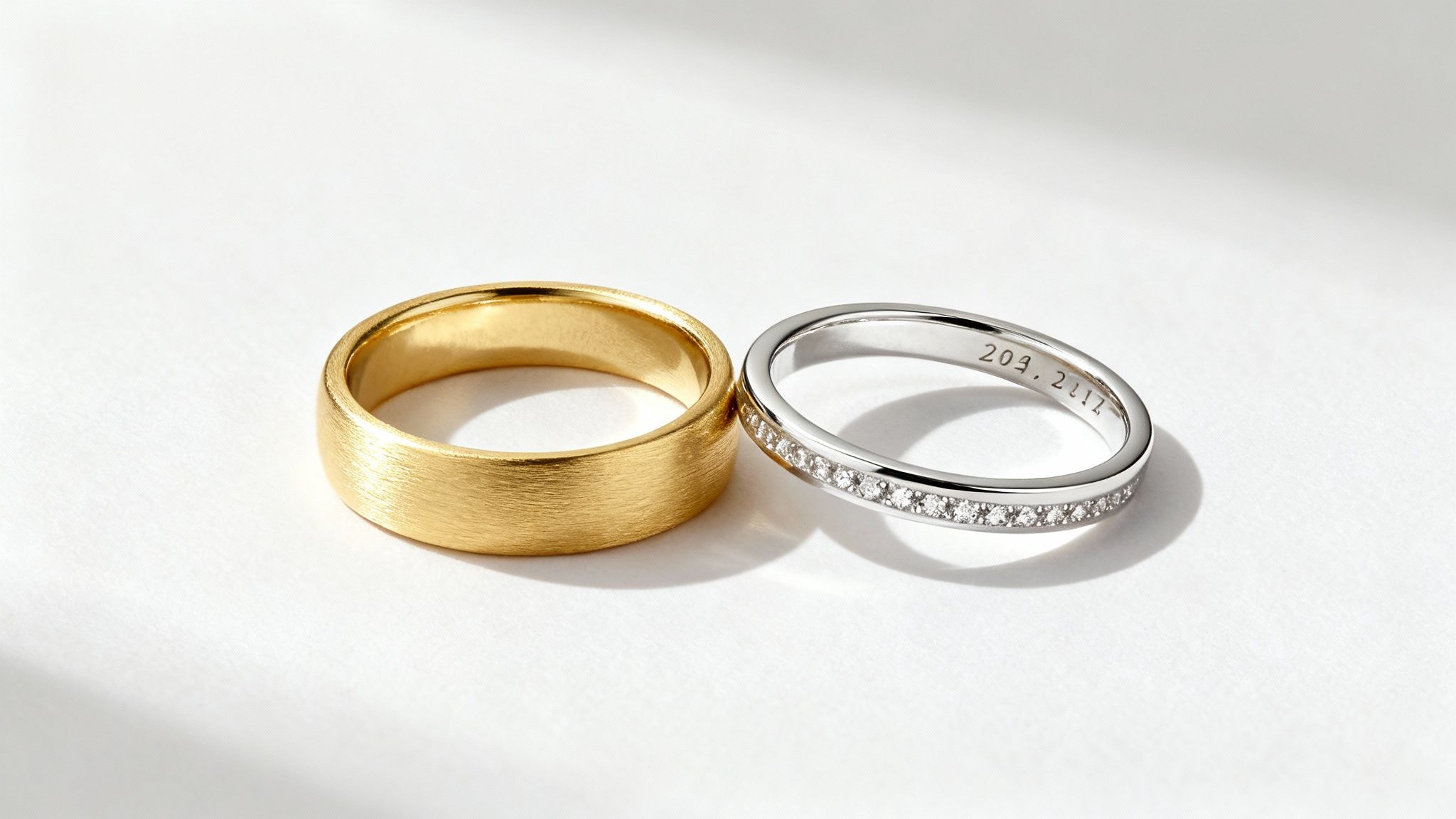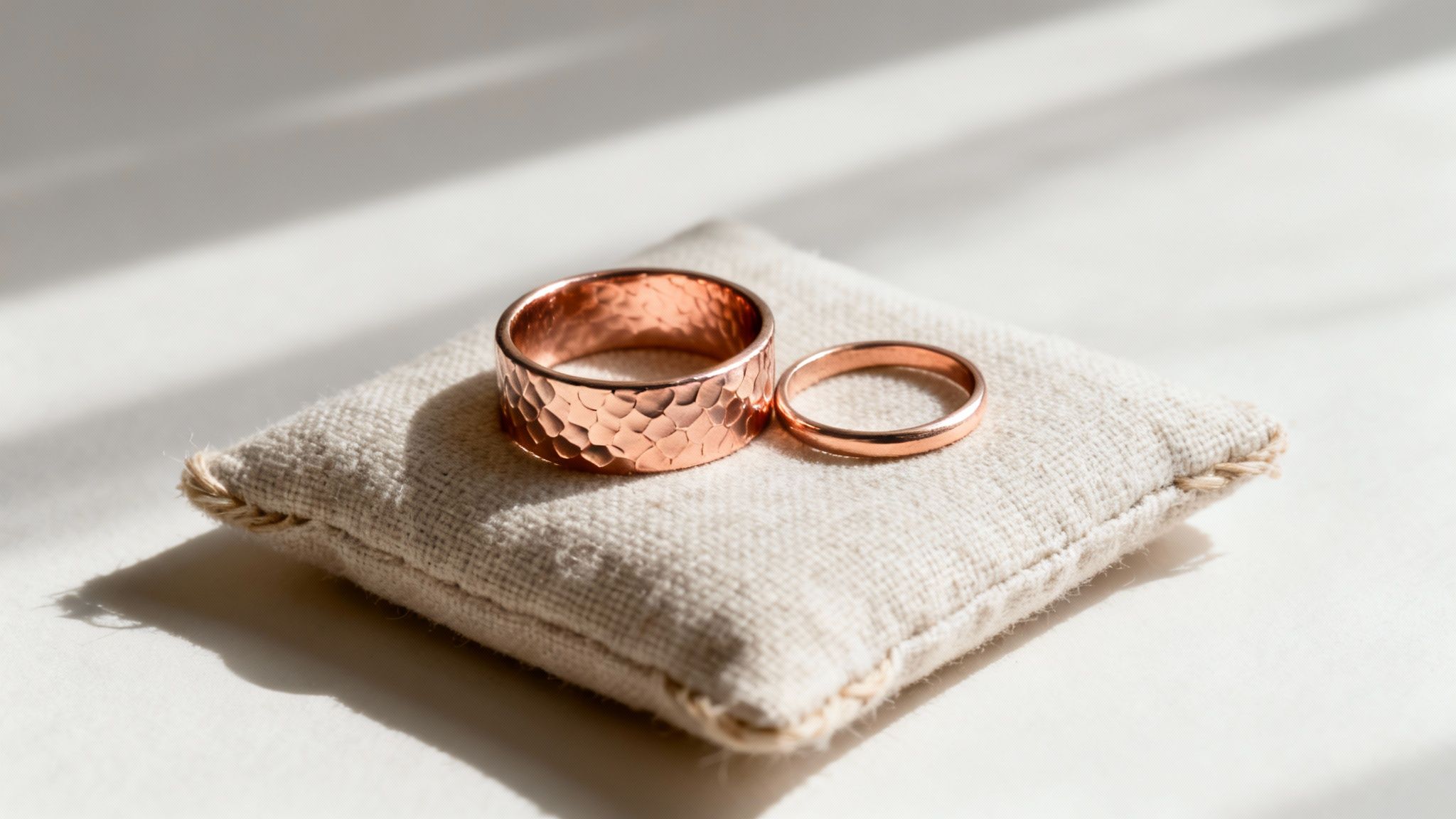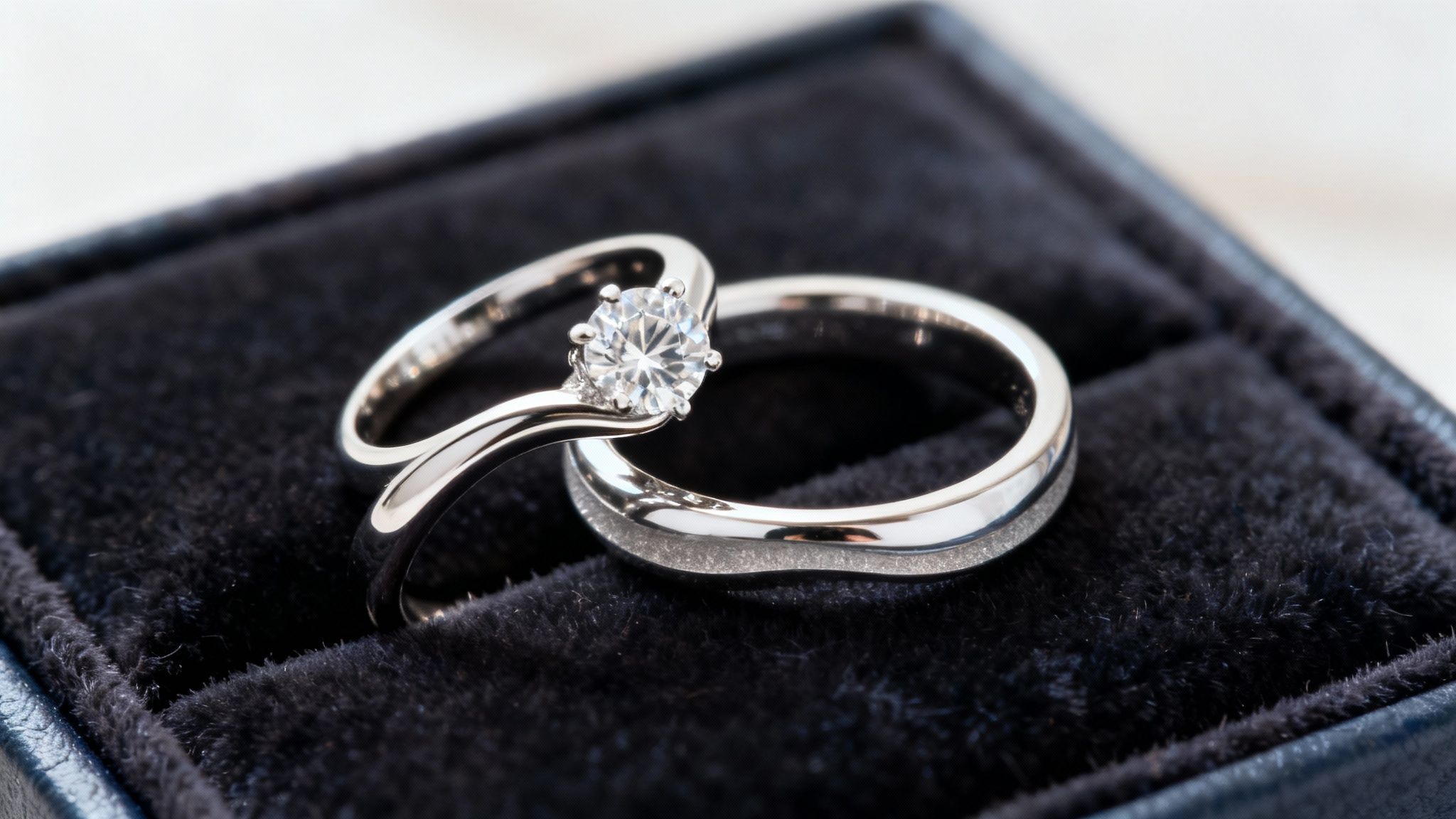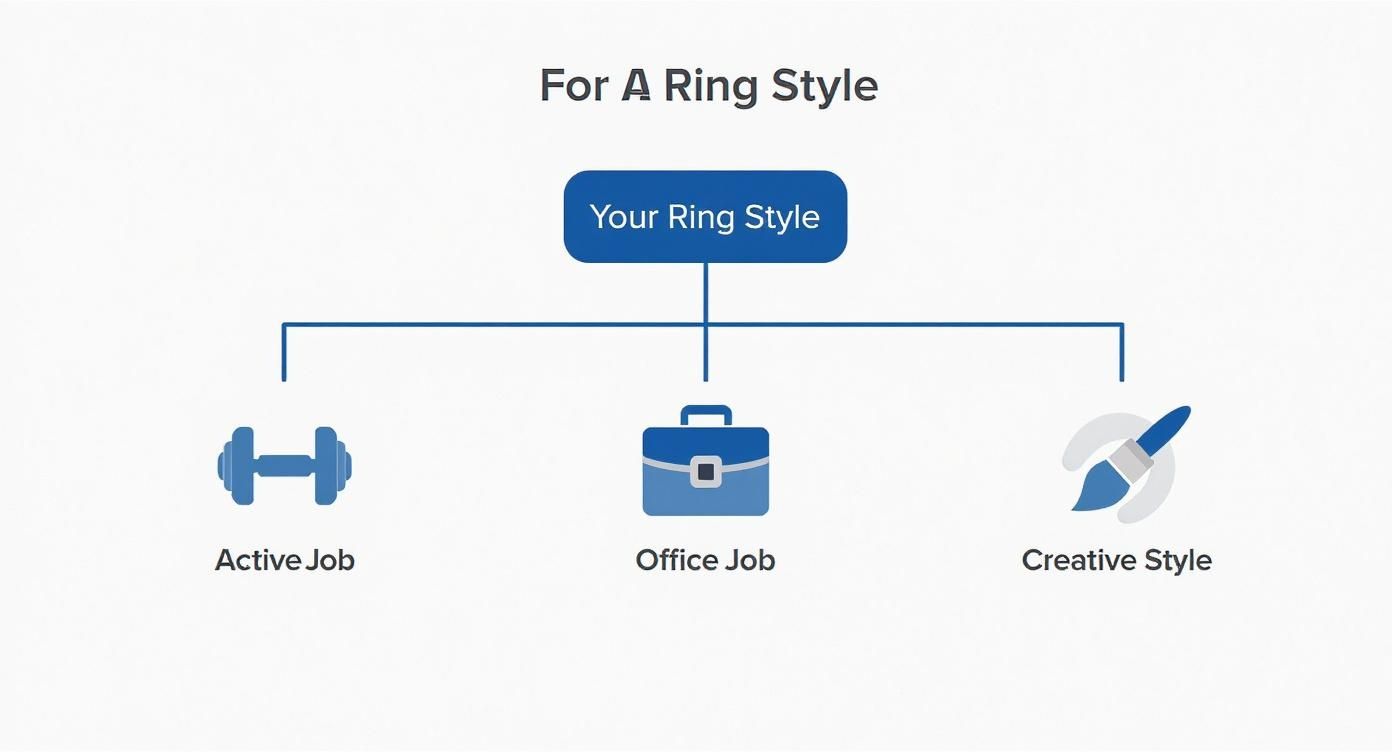Do Wedding Bands Have to Match An Honest Guide
- Luke Zucco
- 6 hours ago
- 13 min read
Let's get straight to it: no, your wedding bands absolutely do not have to match. The old-school pressure to find a perfectly identical pair of rings is officially a thing of the past. Today, it’s all about choosing bands that feel true to you, both as individuals and as a couple.
Breaking Free From Tradition

For a long time, matching wedding bands were the standard—and for good reason. The tradition came from a beautiful idea: two people becoming one unified team. Those identical gold bands were a powerful, visible symbol of togetherness and a shared journey.
But relationships have evolved, and so have our symbols. Modern couples understand that a strong partnership isn't about two people becoming the same; it's about two unique individuals choosing to build a life together. That simple shift has completely opened up the world of wedding jewelry.
The Modern Philosophy of Wedding Bands
The conversation has moved from strict uniformity to authentic personal expression. Think about it: why should a partner with a rugged, hands-on job wear the same delicate, pavé diamond band as their partner who works at a desk? It just doesn’t make sense from a practical standpoint.
While many cultures historically viewed identical bands as a key symbol of a shared life, this norm started changing dramatically in the late 20th century. Today, market trends overwhelmingly point toward customization and personal style. You can see just how much wedding ring traditions have evolved to understand the story behind this shift.
The most meaningful symbol of your commitment isn't a perfectly matched set. It’s choosing rings that you both genuinely love and will be excited to put on every single day for the rest of your lives.
Ultimately, this decision is all about what feels right for you and your partner. Do you love the classic, timeless symbolism of identical rings? Or does the idea of picking out unique bands that show off your individual personalities feel more like you?
To help you figure out where you land, here’s a quick look at the two approaches.
Matching vs Non-Matching Bands At a Glance
This table breaks down the core ideas behind each choice, helping you see which path might be a better fit for your story.
Whether you go for matching, complementary, or totally distinct rings, the goal is the same: to find a symbol of your love that you'll both cherish forever.
How Wedding Band Traditions Have Evolved
For generations, the answer to "do wedding bands have to match?" was a resounding yes. It just wasn't a question people asked. Identical rings were a simple, powerful symbol of two people becoming one unified team. This tradition was all about shared identity—two separate lives merging onto a single path forward.
Think of it like a team uniform. The matching bands clearly said, "We are together, part of the same story." It was a beautiful, visual shorthand for partnership, showing the world that you were both bound by the same commitment.
The Shift Toward Personal Expression
But just as our ideas about marriage have grown, so has the symbolism of the rings. Today’s couples are rewriting the rules, embracing a philosophy that celebrates individuality within the partnership. The focus isn't on two people becoming one anymore, but on two whole, distinct individuals choosing to build a life side-by-side.
This change is part of a bigger cultural shift toward authenticity and self-expression. You can see it in all the top wedding trends, where personalization has become the new standard.
Today's tradition is less about following a specific rule and more about creating your own. The most important thing is that both of you love the ring you'll be wearing every day.
This modern approach confirms what we already know: a strong partnership isn't about losing yourself in someone else. It's about two complete people choosing each other. Your rings can, and many believe should, reflect that.
What the Market Data Shows
This move from strict tradition to personal choice isn't just a feeling—the numbers back it up. The North American market, which accounts for a massive 41% of the $101.5 billion global wedding ring industry, shows a huge difference in what partners are choosing.
While 65% of all bands sold are still classic, plain metal, the details tell the real story. Nearly two-thirds of women now opt for bands set with diamonds, while the vast majority of men's bands remain unadorned metal. This clear split proves that couples are actively picking rings that suit their individual tastes rather than sticking to identical designs. So, if you're choosing different rings, you're not breaking a rule; you're just part of the modern evolution of a beautiful tradition.
Finding Harmony Without Being Identical

So, you’ve decided against identical rings but still want that feeling of connection when you place your hands together. This is where complementary bands come in, hitting that sweet spot between perfectly matched and totally different. It’s less about being twins and more about being in the same family.
Think of it like designing a room in your home. You wouldn’t fill it with furniture from the exact same collection, right? Instead, you create harmony by repeating a color, a texture, or a design style. Your wedding bands work the same way.
This approach honors your shared life while celebrating your individual tastes. It’s a creative way to make sure your rings tell a unified story without either of you having to compromise on what you truly love. The goal is for the rings to look intentional and thoughtful when they’re seen together.
Weaving a Common Thread
Getting that harmonious look is all about finding a shared element that links your two rings. This common thread can be obvious or subtle, but it’s what creates a visual conversation between the bands. It’s the secret ingredient that makes them feel like a true pair.
You have a ton of options for creating this connection. The key is to pick just one or two elements to share, which gives the rest of the designs room to breathe and reflect who you are.
Here are a few popular ways to coordinate:
Shared Metal Type: This is the easiest and most common route. A sleek, polished platinum band for one of you will naturally vibe with a diamond-studded platinum band for the other. The consistent color ties everything together.
Identical Finish: You could both go for a brushed, matte, or hammered finish on rings made from different metals or in different styles. A wide, hammered yellow gold band, for example, pairs beautifully with a delicate, hammered rose gold one.
A Single Design Element: Maybe one ring has a milgrain edge, and the other incorporates that same detail in a more understated way. It’s a small thing, but that shared feature creates an immediate connection.
The real beauty of coordinating bands is in their subtlety. It’s an intimate detail that says, “we belong together,” without shouting it. This reflects a truly modern partnership—one where individuality is celebrated within a strong, unified bond.
Creative Coordination Ideas
Beyond just metals and finishes, you can get even more creative with how you link your rings. Sometimes, choosing bands from the same designer is a brilliant strategy. Their collections often share a distinct aesthetic or design language that makes even very different pieces feel related.
For couples who want something even more personal, a matching engraving is perfect. A shared date, a set of initials, or even two halves of a meaningful quote engraved inside each band creates a private link known only to the two of you. It's a symbol of your connection that’s just for you.
Here are a few more ideas to get you started on finding that perfect, subtle link between your rings.
Creative Ways to Coordinate Non-Matching Wedding Bands
Ultimately, by focusing on coordination rather than perfect replication, you open up a world of possibilities. You get to choose rings you both genuinely love—rings that perfectly represent your unique partnership.
Pairing Your Band with Your Engagement Ring

While coordinating with your partner is one piece of the puzzle, there’s an equally important relationship to consider: the one between your wedding band and your engagement ring. This duo is meant to be worn together for a lifetime, so getting the fit and feel right is everything. You're aiming for a cohesive look, whether that means a perfect match or a stylish, intentional contrast.
Think of your engagement ring as the main event and the wedding band as its perfect supporting act. The band shouldn’t steal the show, but it should definitely enhance the ring’s beauty. This is why many people opt for a bridal set, which comes with an engagement ring and a wedding band already designed to fit together seamlessly.
Buying a pre-made set takes all the guesswork out of the equation. But if you’re after something more personal, creating your own custom pairing lets you craft a look that is uniquely yours. To get a head start, learning how to design an engagement ring can offer valuable insights into creating a unified vision from day one.
Creating a Perfect Fit
When you start pairing rings, the first thing you'll notice is the physical fit. Does your engagement ring’s setting allow a straight band to sit flush against it, or is there a gap? A little space isn't necessarily a bad thing—some people love that stacked look—but if you’re dreaming of a seamless fit, you’ll need a band with a special shape.
This is where a few specific band styles come into play:
Contour Bands: These bands have a gentle curve designed to hug the shape of your engagement ring’s center stone or setting. They close any awkward gaps and create a really snug, cohesive look.
Notched Bands: Just like it sounds, a notched band has a small section cut out. This allows the engagement ring’s setting to slot perfectly into place, like a little puzzle piece.
Ring Guards or Enhancers: These are a bit more elaborate, often made of two bands joined at the bottom. Your engagement ring slides right into the middle, creating a bold, symmetrical frame that really makes a statement.
Your engagement ring and wedding band are a team. The goal is to choose a band that not only complements the ring's style but also respects its physical shape, ensuring both comfort and a stunning visual harmony for years to come.
Matching Metals and Widths
Aesthetic harmony often starts with the basics: metal and proportion. The most traditional approach is to match the metal of your wedding band to your engagement ring (like pairing platinum with platinum). This creates a super unified look and also ensures the metals will wear down at a similar rate over time.
Of course, mixing metals is a huge trend right now and for good reason. A warm yellow gold band paired with a cool-toned white gold engagement ring can create a beautiful, dynamic contrast. The only rule is to make it look intentional.
You'll also want to consider the shank width—that's just the thickness of the band itself. Pairing a delicate, thin engagement ring with an equally thin wedding band creates a lovely, balanced look. On the other hand, a really wide wedding band might overpower a slender engagement ring. The best way to know for sure is to try on different widths and see what feels and looks best on your hand.
Letting Your Lifestyle Guide Your Choice
Ultimately, the most important factor here isn't tradition—it's you. A wedding ring is so much more than a symbol; it’s a piece of jewelry you'll wear every single day. That means it needs to feel like a natural part of your life, reflecting both your personal style and your day-to-day reality.
Think about what you do all day. If you work with your hands as a mechanic, chef, or artist, a durable, low-profile band made from a tough metal like tungsten or titanium just makes sense. An intricate, delicate design probably wouldn't last a week. On the flip side, someone in a corporate role might love an elegant platinum band with detailed engraving that fits right in with their professional attire.
Aligning Rings with Your Personal Style
Your ring should feel like an extension of who you are. Are you all about minimalist, modern aesthetics, or do you gravitate toward vintage, ornate styles? Someone who loves clean lines might pick a sleek, brushed-finish band, while a person with a bolder fashion sense could go for a wide, hammered yellow gold ring that makes a statement.
This is where your individual preferences get to shine. Ask yourself a few questions:
What are your hobbies? An avid rock climber or gardener needs a ring that won't scratch easily or get in the way. A simple, comfortable fit is non-negotiable.
What's your fashion sense? Your ring should complement your everyday wardrobe. Take a look at the jewelry you already wear—do you lean toward silver tones or gold tones?
What feels comfortable? Some people prefer a lightweight feel, while others like the substantial weight of a heavier metal. The width and shape of the band also make a huge difference in how it feels day-to-day.
A wedding band is a deeply personal thing. It has to be comfortable, practical, and a genuine reflection of your identity. If your needs and tastes are different from your partner's, choosing different rings isn't just okay—it's logical.
Global Trends and Personalization
This focus on personalization isn't just a fleeting trend; it’s a global shift in how couples think about wedding jewelry. All over the world, cultural and social factors have led to a huge diversity in ring preferences. For example, North America holds the largest market share at 41%, driven by a mix of traditional customs and a growing emphasis on inclusivity, where personalization often wins out over matching.
Meanwhile, in Europe, trends often lean toward minimalist styles and ethically sourced materials, showing how regional values shape what people choose. You can discover more insights about global wedding ring trends and see just how much tastes can vary. This data confirms it: choosing rings based on your individual lifestyle is a worldwide movement. Our guide to the types of metal for rings can help you find the perfect fit for whatever your life demands.
A Practical Guide to Shopping Together
Shopping for your rings together is easily one of the most exciting parts of wedding planning. Whether you've landed on matching bands or totally unique styles, the real goal is to make it a shared, enjoyable experience—not just another task to tick off the list.
It all starts with open communication. Before you even set foot in a jewelry store, sit down and have a real conversation. Talk about your individual tastes, what the rings symbolize to each of you, and most importantly, agree on a budget that feels comfortable. Getting on the same page from the start saves a lot of stress down the road.
Finding Common Ground
Once you have a shared vision, the fun part begins: actually trying things on. Make a day of it! Visit a few different jewelers to get a feel for the huge range of styles out there. This hands-on approach is the only way you'll truly know what you love.
Be open to trying on bands you might not have considered. A style that looks just okay online can feel absolutely perfect once it's on your hand. And don't forget to ask the jeweler the right questions to make an informed choice.
Here are a few things worth discussing with your jeweler:
How durable is this metal for our lifestyles?
How will this finish wear over time?
What kind of care and maintenance does this ring need?
This handy decision tree can help you narrow things down based on your daily activities and personal taste.

As the graphic shows, practical needs—like whether you have an active job versus an office job—can point you toward the most suitable and comfortable style for you.
While you're juggling appointments, using a solid wedding vendor checklist can be a lifesaver for keeping all your suppliers organized. And for a deeper dive into making that final choice, our expert guide on how to choose wedding bands offers essential tips for your perfect ring.
Turn the whole process into a celebration of your partnership. The goal isn’t just to buy a couple of rings—it’s to create a lasting memory and choose symbols you'll both cherish as a testament to your unique love story.
A Few Final Questions
Even with a game plan, a few questions always pop up. It's totally normal. Let's clear up some of the most common things couples ask when they're on the home stretch of ring shopping.
Is It Bad Luck If Our Wedding Bands Don’t Match?
Not at all. Let's bust this myth right now: the idea that non-matching rings are bad luck is a total fabrication with zero historical roots. The real symbolism of a wedding ring is in its circular shape—an unbroken loop representing your endless commitment. It has nothing to do with the design.
Honestly, the most important thing is that you both look down at your hand and love the ring you see. Choosing bands that feel true to your individual styles is a much more meaningful way to celebrate the unique partnership you've built.
How Can We Make Mismatched Rings Feel Connected?
This is where the fun comes in. You can create a subtle, intentional link between your rings so they feel like a pair, even if they aren't identical twins.
Here are a few ways to do it:
Stick to the same metal. You could both go for 14k yellow gold, but he might choose a wide, simple band while you opt for a delicate, diamond-studded one.
Share a finish. A brushed or matte texture can make two totally different rings feel like they belong together. It's an instant visual handshake.
Get a matching engraving. This is our favorite. A shared date, a private joke, or a line from a song engraved on the inside is a secret just for the two of you.
Another great move is to shop from the same designer. Their collections often share a certain vibe or design DNA, so the rings will feel related even if they’re completely different styles.
Should My Wedding Band and Engagement Ring Be the Same Metal?
Traditionally, the answer was always yes. It creates a very clean, seamless stack and ensures the metals wear down at a similar pace over the years. But let's be real—tradition isn't for everyone.
Mixing metals is one of the most popular trends right now, and for good reason. It looks incredible. Pairing a warm yellow gold band with a cool platinum engagement ring creates a stunning, modern contrast that feels personal and stylish.
The only practical thing to keep in mind is hardness. A super-strong metal like platinum could, over many decades, cause some wear on a softer gold ring next to it. Any good jeweler can walk you through the specifics and help you find a combination that’s built to last.
At Panther De Luxe Shop, we believe your rings should tell your story. Dive into our collection of unique and beautiful wedding bands to find the perfect symbols of your commitment at pantherdeluxe.com.
